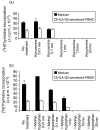Indoleamine 2,3 dioxygenase and human leucocyte antigen-G inhibit the T-cell alloproliferative response through two independent pathways
- PMID: 16236119
- PMCID: PMC1802416
- DOI: 10.1111/j.1365-2567.2005.02224.x
Indoleamine 2,3 dioxygenase and human leucocyte antigen-G inhibit the T-cell alloproliferative response through two independent pathways
Abstract
Both human leucocyte antigen (HLA)-G and indoleamine 2,3 dioxygenase (IDO) are key molecules involved in immune tolerance. HLA-G is a non-classical HLA class I molecule that can be expressed in both membrane-bound (HLA-G1) and soluble (HLA-G5) forms, both of which exhibit tolerogenic properties via interaction with inhibitory receptors present on natural killer (NK) cells, T cells and antigen-presenting cells (APC). IDO is an enzyme that acts by depleting the surrounding microenvironment of the essential amino acid, tryptophan, thereby inhibiting T-cell proliferation. Our present study was aimed at analysing the potential link that may exist between IDO and HLA-G. Our results showed that during allogeneic reactions, soluble HLA-G expression was not regulated by the addition of IDO substrate (i.e. tryptophan), metabolite (i.e. kynurenine) or inhibitor (i.e. 1-methyl-tryptophan), that IDO activity was not altered by HLA-G5 treatment, and that HLA-G5-mediated inhibition of the T-cell alloproliferative response was neither affected by the presence of tryptophan and kynurenine nor reversed after IDO activity blockage, demonstrating that HLA-G5 can exert its function in the absence of functional IDO. Similarly, inhibition of the T-cell alloresponse, induced by HLA-G1-expressing antigen-presenting cells, was not altered by IDO metabolites or inhibitor. Taken together, these findings show that the function and expression of IDO and HLA-G5 are not mutually influenced, but rather inhibit the T-cell alloproliferative response through two independent pathways. IDO and HLA-G are thus complementary for inducing and maintaining immune tolerance in physiological (pregnancy) and pathological (tumour and allograft) situations.
Figures





Similar articles
-
Regulatory role of tryptophan degradation pathway in HLA-G expression by human monocyte-derived dendritic cells.Mol Immunol. 2006 Jul;43(14):2151-60. doi: 10.1016/j.molimm.2006.01.007. Epub 2006 Feb 21. Mol Immunol. 2006. PMID: 16490253
-
Monocyte-derived HLA-G acts as a strong inhibitor of autologous CD4 T cell activation and is upregulated by interferon-beta in vitro and in vivo: rationale for the therapy of multiple sclerosis.J Neuroimmunol. 2005 Feb;159(1-2):155-64. doi: 10.1016/j.jneuroim.2004.09.016. Epub 2004 Dec 28. J Neuroimmunol. 2005. PMID: 15652415
-
Effect of 3-hydroxyanthranilic acid in the immunosuppressive molecules indoleamine dioxygenase and HLA-G in macrophages.Immunol Lett. 2008 Apr 15;117(1):91-5. doi: 10.1016/j.imlet.2008.01.001. Epub 2008 Feb 4. Immunol Lett. 2008. PMID: 18289708
-
Tumor immune escape mediated by indoleamine 2,3-dioxygenase.Immunol Lett. 2007 Aug 15;111(2):69-75. doi: 10.1016/j.imlet.2007.06.001. Epub 2007 Jul 2. Immunol Lett. 2007. PMID: 17644189 Review.
-
The immunoregulatory function of indoleamine 2, 3 dioxygenase and its application in allotransplantation.Iran J Allergy Asthma Immunol. 2007 Dec;6(4):167-79. Iran J Allergy Asthma Immunol. 2007. PMID: 18094439 Review.
Cited by
-
Rapid resolution liquid chromatography coupled with quadrupole time-of-flight mass spectrometry-based metabolomics approach to study the effects of jieduquyuziyin prescription on systemic lupus erythematosus.PLoS One. 2014 Feb 5;9(2):e88223. doi: 10.1371/journal.pone.0088223. eCollection 2014. PLoS One. 2014. PMID: 24505438 Free PMC article.
-
Perspective of HLA-G Induced Immunosuppression in SARS-CoV-2 Infection.Front Immunol. 2021 Dec 6;12:788769. doi: 10.3389/fimmu.2021.788769. eCollection 2021. Front Immunol. 2021. PMID: 34938296 Free PMC article. Review.
-
Nitric oxide produces HLA-G nitration and induces metalloprotease-dependent shedding creating a tolerogenic milieu.Immunology. 2009 Mar;126(3):436-45. doi: 10.1111/j.1365-2567.2008.02911.x. Epub 2008 Sep 1. Immunology. 2009. PMID: 18764882 Free PMC article.
-
Involvement of kynurenines in Huntington's disease and stroke-induced brain damage.J Neural Transm (Vienna). 2012 Feb;119(2):261-74. doi: 10.1007/s00702-011-0676-8. Epub 2011 Jun 22. J Neural Transm (Vienna). 2012. PMID: 21695417 Review.
-
TDO as a therapeutic target in brain diseases.Metab Brain Dis. 2016 Aug;31(4):737-47. doi: 10.1007/s11011-016-9824-z. Epub 2016 Apr 13. Metab Brain Dis. 2016. PMID: 27072164 Review.
References
-
- McMaster MT, Librach CL, Zhou Y, et al. Human placental HLA-G expression is restricted to differentiated cytotrophoblasts. J Immunol. 1995;154:3771. - PubMed
-
- Sedlmayr P, Blaschitz A, Wintersteiger R, et al. Localization of indoleamine 2,3-dioxygenase in human female reproductive organs and the placenta. Mol Hum Reprod. 2002;8:385. - PubMed
-
- Uyttenhove C, Pilotte L, Theate I, et al. Evidence for a tumoral immune resistance mechanism based on tryptophan degradation by indoleamine 2,3-dioxygenase. Nat Med. 2003;9:1269. - PubMed
-
- Carosella ED, Moreau P, Le Maoult J, Le Discorde M, Dausset J, Rouas-Freiss N. HLA-G molecules: from maternal–fetal tolerance to tissue acceptance. Adv Immunol. 2003;81:199. - PubMed
Publication types
MeSH terms
Substances
LinkOut - more resources
Full Text Sources
Research Materials

